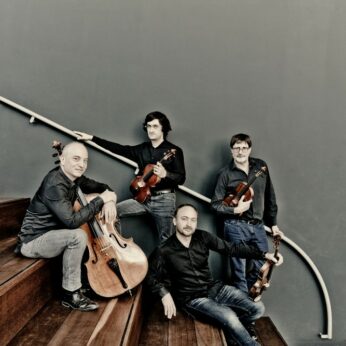Composer: Mieczyslaw Weinberg (b. 1919 - d. 1996)
Performance date: 30/06/2022
Venue: St. Brendan’s Church
Composition Year: 1964
Duration: 00:22:32
Recording Engineer: Simon Cullen, Ergodos
Instrumentation: 2vn, va, vc
Instrumentation Category:String Quartet
Artists:
Quatuor Danel (Marc Danel, Gilles Millet [violins], Vlad Bogdanas [viola], Yovan Markovitch [cello] -
[quartet]

String Quartet No.10 in A minor Op.85 [1964]
1. Adagio – attacca
2. Allegro – attacca
3. Adagio – attacca
4. Allegretto
Weinberg’s Tenth Quartet was dedicated to Olga Rakhalskaya, who was a philology student at Moscow State University in her twenties and a friend of his daughter Victoria. They went back to the Weinberg’s home to study. Several years later Weinberg and Olga got married and Nataliya and Victoria emigrated to Israel. As Olga put it – his indecision lasted five years. Weinberg’s separation from the Mikhoels family, a name so prominent in Soviet Jewish life, meant many acquaintances turned their back on him. This Quartet was written immediately after Shostakovich wrote his Tenth Quartet, which he dedicated to Weinberg, something that made the younger composer immensely proud. So the two composers’ quartet competition was now level. On the manuscript score the first movement is titled Aria, though the title is missing from the printed version. It is a tremendous movement, a great outcry supported by huge chords as if strength is being wrung out of pain and distress. Eventually it slowly subsides into one of his typically drawn out endings with no clear conclusion until the cello ushers in a nervy, shadowy, muted kind of Scherzo. This could be a dance if you follow the ever-present pizzicato rhythms, folk-like for sure with a hint of klezmer. After a notated pause, the second Adagio is announced with great shuddering chords holding up a passionate declamation from first violin and cello, developing the Aria from the first movement. The cello again leads the way into a softly spoken Finale that for a moment looks like heading for a traditional darkness into light conclusion. But we know by now Weinberg almost never takes the easy route, wisps of themes are passed around, a shred of a dance maybe. He keeps us waiting for some outburst, holding the tension until the music just drifts away.
Francis Humphrys
Copyright © 2024 West Cork Music. All rights reserved.
Designed and developed by Matrix Internet